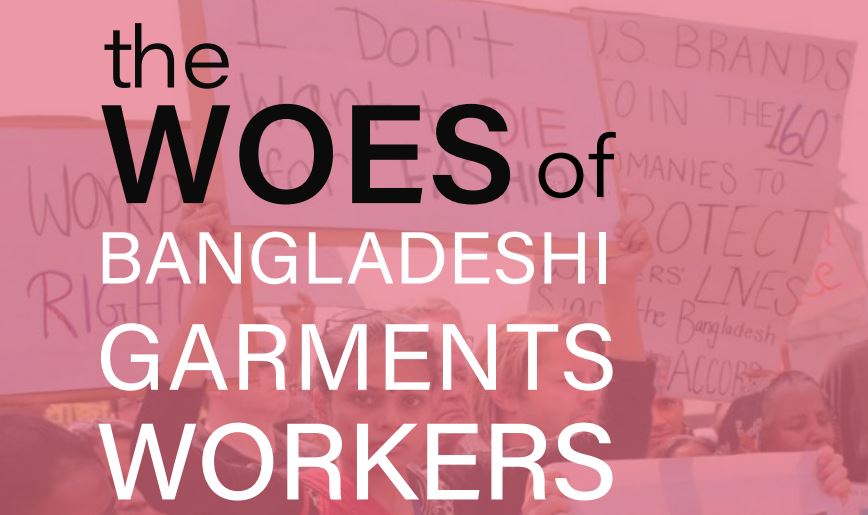“I thought about killing my children”, aid Azad, a garments worker from Dhaka, Bangladesh. She was among the protesters at the press club last year, demanding payment from the employers. They were all beaten by the police and removed from their peaceful stance, but that is not something we remember vividly. What we do remember is the #PayUp movement on social media. We heard Kylie Jenner is not paying the garments workers in Bangladesh and we texted her on Instagram asking for money. The #PayUp movement was successful in many ways, thanks to the massive reaction of the internet. However, most failed to perceive the grim situation and how deep its roots go.
Before Covid-19 caused #PayUp, what was the biggest scandal of the garments industry that we remember?
I’m sure we are all thinking of the Rana Plaza tragedy right now. It takes events of such scale to get a reaction out of the general people, and even that, is fleeting.
The Rana Plaza tragedy, or just before that, the Tazreen Fashion fire, expose the lack of investment in infrastructure. The Rana Plaza building collapsed because the building safety was not even a secondary concern. The garments worker in Tazreen Fashion died because their building did not have appropriate fire exits. These shortcuts are taken to cut costs.
Places like Bangladesh, where you can cut costs by compromising building safety, grossly underpaying the workers, and overworking them to their limits, are absolute gold mines for fast fashion brands. Zara, Forever21, GAP are some of the biggest names in this industry, and yes Kendall+Kylie too.
Fast fashion put simply, is mass-producing clothes that follow the latest fashion trends at a cheap rate. Fashion changes faster than ever now, everyone wants to be in the loop and look their best. This has created a massive demand for fast fashion brands. But as these trends change quite fast, everyone can’t buy expensive clothes all the time. So, making way for the $5 t-shirts in the west only required destroying the environment and exploiting the workers. We will only focus on the latter here, but the environmental effects are also quite frightening.
Bangladesh earns $40 billion from exports annually, 80% of that comes from the RMG sector. This makes it the second-largest exporter of RMG in the entire world, but hiding behind that is the terrible treatment of 4.4 million garments workers.
Since 2018, the minimum wage for the garments workers has been set to BDT 8,000 or USD 95 per month in Bangladesh. But in reality, workers are getting paid as low as BDT 2,000 or USD 25 a month. On top of that, they they rarely get paid on time. The factories keep running on accrued wages for months. We have all scrolled through the news of workers protesting for their unpaid wages now and then. BDT 2,000 or even 8,000 is not enough to survive for a month with a family in a city like Dhaka. They are getting paid far less than what one would consider a living wage.
But the exploitation does not end there. These people are not working your standard 9-5 jobs. They have to work as much as 14-16 hours a day, 7 days a week. And this insane amount of work hour with barely any break still does not draw the full picture. They do not just work by the hour; they are also put under enormous pressure to maximize the production. This results in making them produce inhuman amounts of output every single hour. The low wage of BDT 2000-8000 a month with delayed payment looks much worse now, doesn’t it?
All of this is done to meet the demand of the west. Data from 2015 shows that 80 billion pieces of clothing are produced in a year resulting from fast fashion demands. This leads to the overworking of the garment workers. And they are grossly underpaid to keep the price at its cheapest. But cheap labor alone doesn’t cut it for these brands. To cut costs even further, countries with weak safety laws and even weaker implementation come to the rescue.
These factories do not have proper ventilation systems, these are sweatshops. The workers inhale harmful chemicals, toxic substances, fiber dust, and blasted sands. Workers working in these conditions are immensely prone to diseases, and they are abused for not reaching their insane hourly target. They don’t get proper breaks to even go to the bathroom or drink water, this makes the lack of hygienic or any bathroom at all as well as the lack of safe water only a secondary concern. 85% of these workers are women, and they have it much worse. 1 in every 4 women gets sexually harassed or abused here, which is definitely not the real number and also does not include the harassment they face during commute.
The buildings have no proper fire exits, they have a terrible infrastructure. 1,134 people died in the Rana Plaza tragedy, 114 died in the Tazreen Fashion fire. These incidents happen all the time. It is estimated that 1.4 million injuries happen every year. Most of these workers are never compensated for their loss or even given proper medical support to get well. The few feel-good stories you see are mainly performative activism which is a minuscule percentage of the total picture. And these workers are not even allowed to protest; only 10% of the garments have labor unions. But they aren’t allowed to protest either. They get threatened, they get beaten up by their employers, the police, and the hired goons. 60% of the workers have reported threats or physical abuse, but we all know the reality is much worse.
We were talking about the police beating up protesters at the press club last year. We talked about Azad wanting to kill her children. She wanted to kill her children and then herself because she had no food for two days straight. That is the picture after Covid-19 struck the industry. Workers claim it is worse than the Rana Plaza tragedy. Fast fashion brands cancelled orders worth USD 3-4 billion during the pandemic. And what was worse is they refused to pay the price of many completed and delivered work as well. Bangladeshi garments shut down due to the lockdown, many of which never opened up again. The workers did not get paid for the work they did before the pandemic, and over 96% of factories did not follow compensation protocol and committed wage theft.
As the situation stands, workers are unemployed and unpaid while many fashion brands are reporting profits over $10 billion during the pandemic.
One of the proposed solutions amidst the uproar against fast fashion is switching to slow fashion. Which is essentially fewer clothes produced, and many recycled. This would reduce the pressure on workers as well as the environmental hazards.
Poverty in Bangladesh went from 80% to 30% in fifty years thanks to the RMG sector’s success. If fast fashion slows down, there will be lay-offs of unprecedented numbers. If the 4 million workers become 1 million, how will the rest survive?
I don’t know the solution, but I am sure the first step is to start searching for one.




